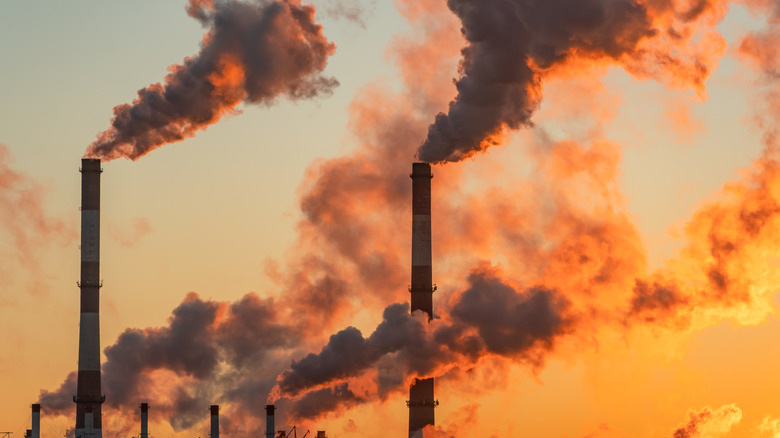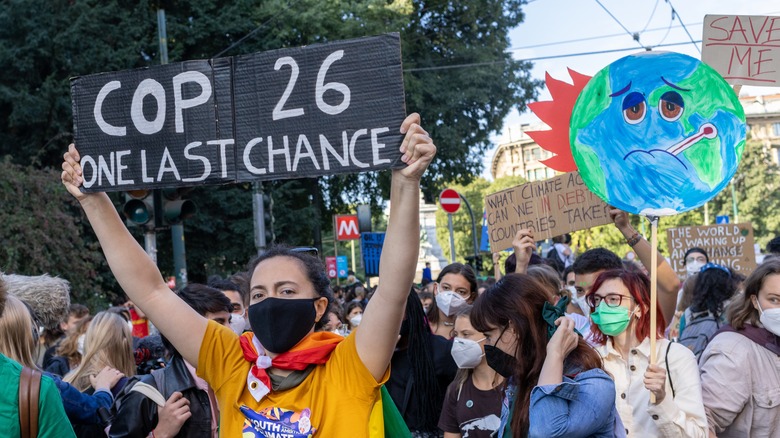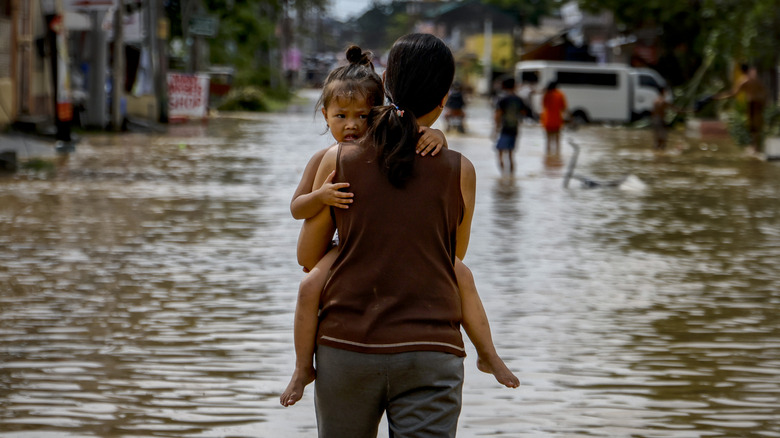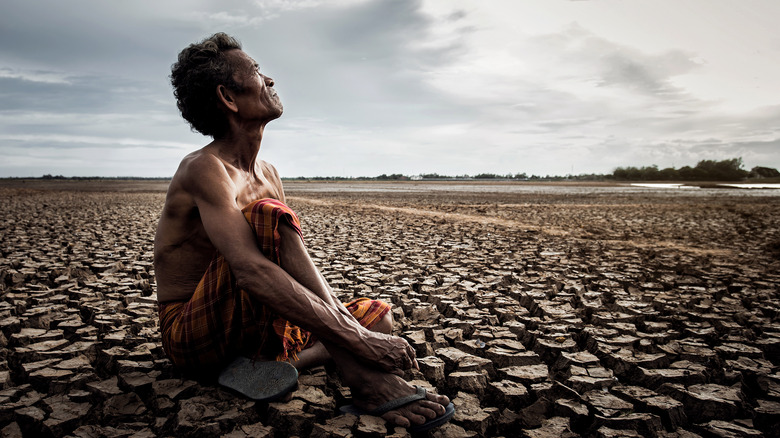This Is What Climate Anxiety Does To Your Brain, According To Science
You've probably heard of mental illnesses like depression, generalized anxiety disorder, and social anxiety disorder. But have you ever heard of climate anxiety? Also called climate stress or climate distress, climate anxiety is the fear and dread that people experience when they think about climate change and the impending climate crisis (via The Washington Post). For example, if you experience a lot of anxiety when thinking about planning for retirement because you're worried that climate change will have destroyed the world by then, that might be a form of climate anxiety.
A lot of people are affected by climate anxiety — over two-thirds of adults experience the anxiety in some form, according to a survey from the American Psychological Association — but kids are the most affected. In fact, according to one survey, 60% of young people count themselves as worried or very worried about climate change, while only 5% of people aren't worried about it at all (via Nature). And fears are especially high in countries like India and the Phillippines, where the impacts of climate change are already being felt (via Wired).
These fears might be understandable, but that doesn't mean they're easy to deal with. In fact, climate anxiety can have a bunch of impacts on young people's psyches, which is why many doctors and universities are trying to come together to find a solution.
If you or someone you know needs help with mental health, please contact the Crisis Text Line by texting HOME to 741741, call the National Alliance on Mental Illness helpline at 1-800-950-NAMI (6264), or visit the National Institute of Mental Health website.
The climate crisis
Climate change describes a general change in weather and global temperatures over time, according to the United Nations. A huge part of this is rising global temperatures: On average, temperatures are expected to rise by more than 3 degrees Celsius by 2100, a change that would have a huge impact on various habitats and ecosystems.
But it's not just about how sweaty you'll get in the summer. Higher temperatures can change lots of global weather patterns, increasing the frequency of events like droughts and severe storms, which can be deadly (per the Environmental Defense Fund). Moreover, as global temperatures rise, ice in the Arctic will melt, and sea levels will rise, threatening many cities that sit at or close to sea level. In fact, as many as 226 million people in some of the world's major port cities are expected to be affected by rising sea levels, which could drown cities including Tokyo, London, and New York City unless flood management measures are put in place (via The Swiftest).
How climate change will affect the world
These changes will potentially have huge impacts on people's day-to-day lives — though exactly how things will change depends on where they live. As port cities flood, urban migrants will be pushed out of their homes and into new cities or the countryside, causing massive disruptions in local economies, according to World Bank Blogs.
Even for those who don't have to move, day-to-day behavior might change. Increased threats of wildfire and drought may push people to change their behaviors around water and water usage. Other changes might come from disruptions in the agricultural system due to drought and changing weather patterns, according to The New York Times. As a result, goods could get more expensive, making it harder for lower-income households to make ends meet. And changing weather alone can have significant impacts on our physiology — even if we don't realize it. For instance, higher temperatures mean people don't sleep as well at night, according to Global Citizen.
How this causes climate anxiety
It's pretty clear how these kinds of changes can be alarming. But how specifically do they lead to climate anxiety? Part of it might be related to physiological responses, according to Harvard University. They note that it's not just the logical dread and fear of climate change that causes anxiety — actual physical impacts of climate change can have an effect as well, with research showing that there are more emergency room visits for psychiatric concerns when temperatures are warmer than usual. And in some Canadian provinces experiencing higher heat, climate anxiety was higher as well (via CBC). It's not clear exactly why this is, but it doesn't bode well for mental health on our quickly-warming planet.
According to Britt Wray, a mental health researcher at Stanford University, one key thing to understand is that though climate anxiety is uncomfortable, it's not necessarily itself a problem. "It's actually a very healthy and normal response to have when one understands the escalating civilizational threat that we're dealing with when it comes to the climate crisis," she says, according to Smithsonian Magazine. "However, it can become a huge problem if the feelings become so severe that a person starts to lose their ability to function and access wellbeing and get through the day."
What the anxious brain looks like
Some of climate anxiety is sort of like a grief response, according to NPR. In addition to feeling fear and dread about the future, one may also feel sad about the impending loss of "normalcy" to climate change. But there's also a very real stress and anxiety response that can kick in when a person thinks about climate change, NPR notes. When the fear system kicks in, one can experience a fight or flight response.
In a flight or flight response, the person see spikes in stress hormones such as adrenaline and cortisol, according to Verywell Mind. These hormones incite the body to respond to something — but, in the case of climate anxiety, there aren't necessarily any concrete steps the person can take to alleviate the fear. It's not like they're being faced with a tiger, where they can mobilize their legs to run. The threat of climate anxiety is abstract. Over time, persistent anxiety can wreak havoc on the brain and actually damage sections like the hippocampus, according to a review in Current Opinion in Psychiatry. It can also make people more susceptible to other mental illnesses, like depression.
Efforts to treat climate anxiety
With the growing problem of climate anxiety has come a growing awareness of the phenomenon. There are plenty of different people and institutions working to find the best ways to manage climate anxiety, including schools and colleges, which have a large concentration of young people who may experience climate anxiety. For instance, at the University of Michigan, researchers created a test group of students who met up every week to discuss climate anxiety (via The Washington Post). Support groups like this could be a great way for students to find community in their struggles.
If that type of support group isn't available, experts recommend trying to find someone else to talk to — be it a friend, family member, or, ideally, a therapist, NPR reports. Though therapists currently do not need to have any sort of training in climate anxiety to be licensed, there are people who are creating climate anxiety-specific training programs that could be useful in the future. Mental Health UK also suggests using personal interventions, like exercising more and mobilizing anxiety for an environmental cause.
If you or someone you know needs help with mental health, please contact the Crisis Text Line by texting HOME to 741741, call the National Alliance on Mental Illness helpline at 1-800-950-NAMI (6264), or visit the National Institute of Mental Health website.





